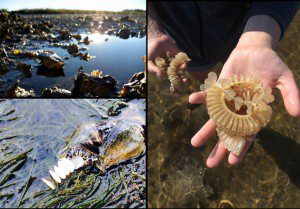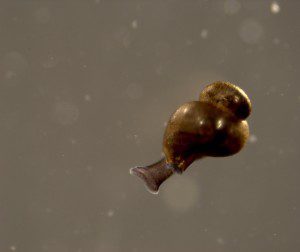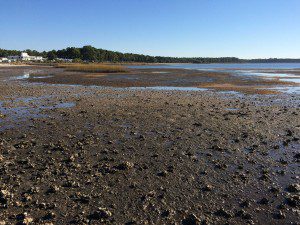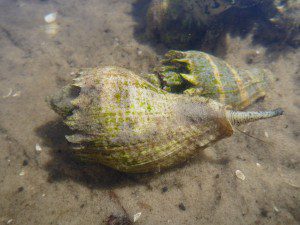We’re pleased to introduce our newest blogger, Jessie Mutz. A graduate student in the Florida State University Department of Biological Science, Jessie will be taking a closer look at some of the many fascinating plants and animals in our area. In the process, she’ll introduce us to FSU students and faculty conducting research across various ecosystems. She starts in a place familiar to this blog when it comes to FSU research- our very own Forgotten Coast.
Jessie Mutz Graduate Student, FSU Department of Biological Science
With summertime officially and emphatically here in North Florida, many of us are coastward bound. Like long walks on the beach? As it turns out, you’re not the only one.
Meet Dr. Scott Burgess, a marine evolutionary ecologist and one of the newest faculty in FSU’s Department of Biological Science. Although it’s only the start of his first full summer in Tallahassee, Scott has already been hitting the beach – a prime location for researching the reproductive strategies of intertidal invertebrates like the crown conch, Melongena corona. “This area has a lot of species with an unusual life history type, one that is typically less common in other areas,” he says. “So that’s a big interesting thing: Why are there lots of these weird ones here? Why have all of the species chosen this particular life history in this area of the world?”
This “unusual life history type” is known as direct development, or when juveniles hatch as essentially little versions of adult snails instead of floating around as microscopic plankton, the way that oysters or even other types of snails do elsewhere around the globe. When visiting the gulf, you can literally stumble upon one result of this quirk: lots and lots of egg cases strewn about in the sand or the shallows, directly underfoot. That’s right – those oddly-shaped, dried-up, crusty structures are actually egg capsules left by various residents of the intertidal, from crown conchs to lightning whelks to banded tulips. And if you indeed enjoy long walks on the beach, you’re sure to encounter a great many of these this time of year.

Examples of egg cases, clockwise from top left: gulf oyster drill (Urosalpinx sp. or Eupleura sp. ), lightning whelk (Busycon contrarium), crown conch laying eggs (Melongena corona). Photos taken at FSU Marine Lab and Wakulla Beach by Scott Burgess.
But where those egg cases are left is where the questions start: How does a crown conch decide when and where to lay her eggs? Should she produce many small eggs or just a few larger ones? And what does this one reproductive act – by a single individual – mean for the entire population?
The Burgess lab considers these kinds of questions both through generations and throughout the lifespan of individuals. Especially for marine organisms, individuals often change drastically from microscopic, free-floating larvae to much larger (and even sedentary) adults. As you might imagine, the challenges to survival can be very different between one stage and the next. For example, a location best suited for a mother laying eggs – that is, away from predators – may actually put the eggs at greater risk for drying out, whereas an ideal place for egg development could leave the new hatchlings in a lousy spot to find food (see Spight 1976).
What is a mother to do? Either way, those developing embryos will be affected.

A newly-hatched crown conch. This individual is about 700 microns (0.7mm) long. Photo by Scott Burgess.
Well, there’s a term for that – aptly, “maternal effects” – and these occur when the environment experienced by the mother influences the traits of her offspring beyond the genes she passes on. Most of the time this happens passively, but it can also result from a behavior, such as where a crown conch (or an ovipositing insect, as another example) lays their eggs.
In many cases, maternal effects are adaptive, “a way for mothers to give their offspring traits to survive in the environment that the offspring are going to experience,” explains Scott. “So, preparing them for the future environment.” For conchs, this could be by helping them to better tolerate environmental stressors like high salinity or high temperature. Some of Scott’s work on marine bryozoans, for example, found that parents raised in warm water produced offspring that were more successful at any temperature than those from parents raised in cool water. But then, maternal effects can also be “selfish,” benefitting the mother at the expense of the offspring’s fitness (Marshall 2007).
Trade-offs and maternal effects are undoubtedly something to which our own species can relate. A famous human famine study followed children whose mothers had experienced the Dutch Hunger Winter of 1944-1945, finding undernutrition early on in gestation to be associated with a higher risk of obesity in adulthood. This result was framed as kind of maternal effect by the authors, who proposed that famine exposure in utero affected development of the areas of the brain controlling appetite and food intake, with long-lived repercussions.
And then there are the parenting trade-offs once they’re born: taking a promotion vs. more time with the kiddos, how to handle discipline. Certainly, the decisions we make based on our own environment affect the way our children interact with theirs.
While Melongena corona doesn’t do much parenting by our human standards, how and where they provision their young can set those offspring up for success – or for a real struggle to survive. And with environmental conditions becoming even more extreme and unpredictable, like the changes in salinity and temperature being seen around our own Gulf Coast, these extra parental cues could be part of the difference between a declining population and an outbreak. “The ability of mothers to ‘condition’ their offspring like this may be a big way for that species to deal with environmental change,” Scott adds. “We don’t know yet – we’re trying to figure that out.”
So, during your next summertime stroll along the shore, consider the case of the egg cases – those tough decisions, inter-generational effects, and what it means to be a parent in a changing world.

Southern oyster drill (Thais haemastoma) egg casings on Apalachicola Bay oysters. In their investigations into the collapse of the Apalachicola oyster fishery (which we followed on this blog), Dr. David Kimbro and Hanna Garland often found drill egg casings on their experimental oysters and oyster cages. Low river flows led to higher salinity in the bay, which resulted in an explosion in crown conch and oyster drill reproduction.


